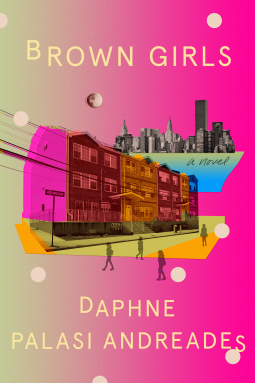Brown Girls: A Review By: Paloma Lenz

 Daphne Palasi Andreades’ Brown Girls is a wild ride from the “dregs of Queens” and out and into the incredible rollercoaster of life.
Daphne Palasi Andreades’ Brown Girls is a wild ride from the “dregs of Queens” and out and into the incredible rollercoaster of life.
The frank and poetic narrative voice unveils the shared experience of brown girls encountering everything from casual racism from teachers who mispronounce their names or rename them to kissing boys and discovering their romantic feelings for other girls. A soundtrack of Mariah Carey, Aaliyah, Selena Quintanilla, and Beyoncé plays in the background.
The brown girls are first-generation Americans whose parents hail from countries in the Caribbean, Latin America, Asia, and Africa. They’re navigating the stoops and sidewalks of their Jackson Heights neighborhood from a young age while also trying to be the good girls their mothers beg them to be. But any brown girl growing up in the USA knows that the outside world sees you how it wants to see you, and reconciling those two versions of yourself is the eternal struggle for people of color in the land of the free.
So our brown girls push forward. Some stay loyal to the streets that raised them, but others choose to pursue education outside their neighborhood boundaries, beginning with high school, to the dismay of both their friends and family. A chorus of “you think you’re better than us” resounds as these brown girls pursue opportunities while trekking across their great city on foot, on the bus, on subways. But, the omniscient narrator subtly questions, why shouldn’t they be able to explore? Their parents crossed oceans for better lives. The urge to discover more in life is in brown girls’ blood.
There is no main character to keep track of in this story. Instead, the narrative voice takes you through the lives of brown girls as pre-teens into adulthood. The girls are caught laughing, talking smack, screaming, singing, crying, sneaking out of the house, attending college, and visiting ancestral lands as young adults. On their trips, family members they haven’t seen in decades or have just met share images of their mothers with them. The girls try to recognize their mothers in the young, smiling women captured in the photos they hold in their hands and wonder how they could have traveled across oceans alone to become the mothers that raised them.
One of my favorite parts of the book is when the girls become women who recognize the sacrifices and stories their mothers carry with them. They call their mothers. They write to their mothers. They finally see their mothers as individuals and not just symbols of the immigrant experience and the diasporic divide between generations. They begin to see their mothers as women with their own stories to tell.
The writing is fast-paced and will have your heart-pumping as our brown girls discover everything they are capable of and more.



